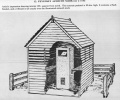Spider
A spider is a fixture, set into the top of triangulation pillars, for mounting theodolites. It is described in The History of the Retriangulation of Great Britain [1] as follows:
Into the top of the pillar is set a brass fitting called a 'spider' incorporating three grooves 120° apart. The spider ensures that instruments can be automatically centred over the intersection of the three grooves when the feet of the tribrach of the instruments are placed in the grooves.
There is no deliberate orientation to the spider, apart from making it symmetrical to the top (i.e. one arm points to the centre of one side). [2]
In the middle of the spider is a removable central plug.
A list is available on T:UK
A spider may occur as part of a non-standard pillar, for example: Louven Howe Aux 1 Occasionally, spiders can also be found set into other structures such as water towers, church towers and sea walls. They were also used on Bilby Towers.
Overgate Croft Farm - a standard spider and pillar
Louven Howe Aux 1 - non-pillar base
A spider set in a sea wall
Newcastle University - non-OS pillar and spider
Occasionally, linear marks on the spider show where the tribrach or surveying equipment was dropped or dragged across the surface; for example at Errington Wood. Spiders are often marked with graffiti. However, for a number of West Midlands pillars the neatly incised inscription TS=JD appears. The reason for this is unknown but a plausible suggestion is that TS denotes 'Trig Station' whilst JD are the initials of the pillar builder. Some examples are at: Walton Hill, Berrow Green, Field Farm, Flagstaff Wood Abberley, Frankley Beeches, Hillocks Farm, Kinver Edge and Lea Castle Estate.
15 instances of non-pillar spiders are recorded in the OSGB36 list [3].
Of these, 7 have been destroyed:
- North Anston Water Tower
- Worksop Water Tower
- Cement Mixer
- East Cowes
- Esplanade
- Sea Wall
- Four Ashes Wireless Mast East
2 are possibly missing:
3 are unknown and/or inaccessible:
3 are known to exist:
- Lincoln Minster (end of spider just visible from the roof)
- Pevensey Azimuth Mark
- Sea Wall
References
- ↑ The History of the Retriangulation of Great Britain 1935-1962, p.14, Section 2.061
- ↑ email from Ian Wilson to the Trigonomy mailing list, 22/08/2009
- ↑ https://www.ordnancesurvey.co.uk/legacy/docs/gps/CompleteTrigArchive.zip





